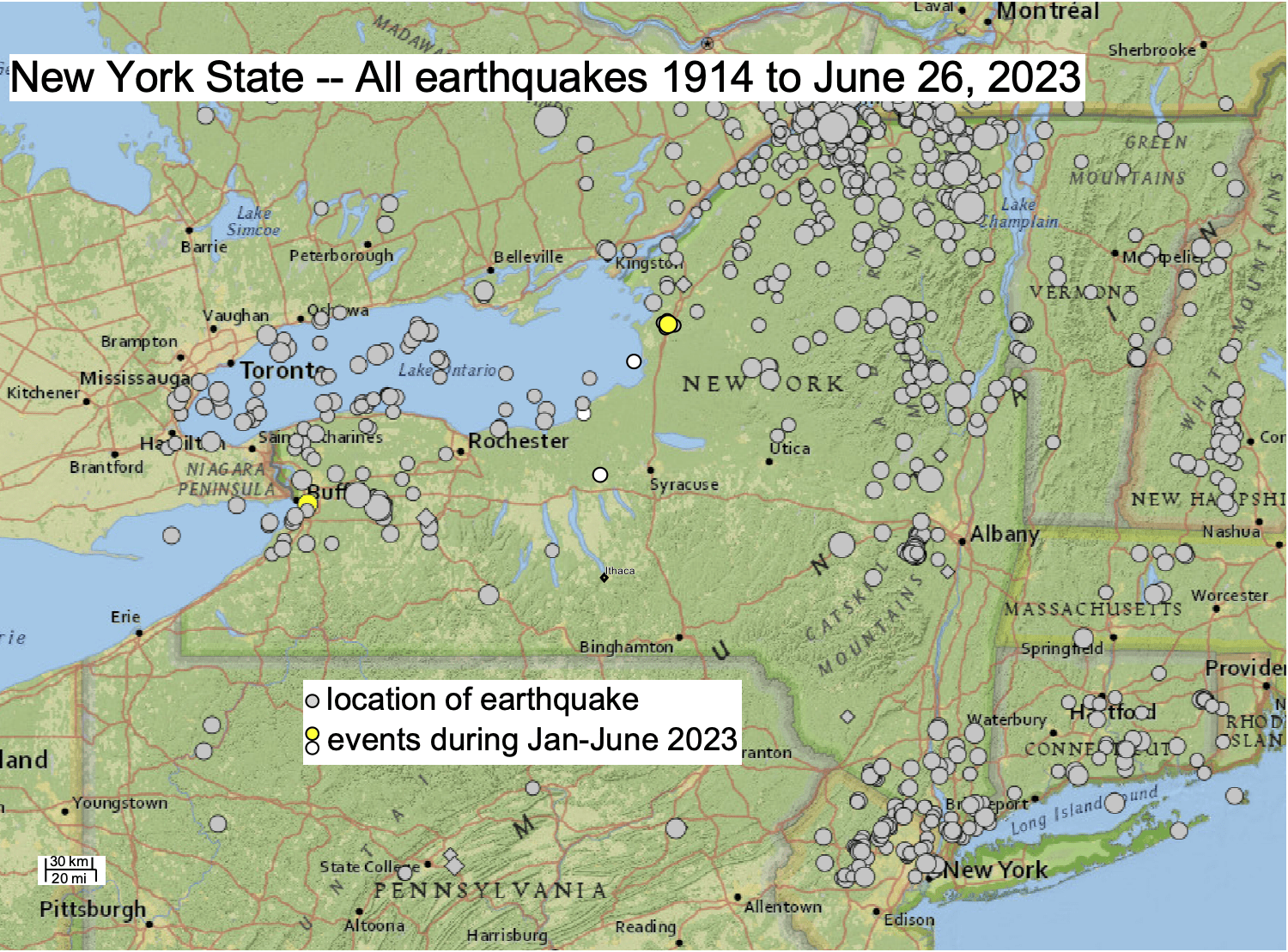**Earthquake Hazards in New York Tri-State Area** Recent studies have shed light on the earthquake hazards facing the New York metropolitan area. Here's what we know: **Past Earthquakes Provide Clues** Historical records show that the Northeast has experienced earthquakes in the past, including: * A magnitude 3.8 earthquake in Buffalo in 1988 * A magnitude 4.0 earthquake in New Jersey in 2018 **Fault Lines in the Region** The Ramapo Fault Zone, located in Rockland County, New York and northern New Jersey, is a potential source of earthquakes in the area. **Quaternary Faults in Western New York** Quaternary faults, those that have been active in the past 2.6 million years, have been identified in western New York, including the Clarendon-Linden fault system. **Assessing Hazard** While major earthquakes are rare in the Northeast, it is important to understand the potential risks. The location and magnitude of past earthquakes provide valuable information for assessing earthquake hazard. **Prepare for the Unexpected** Residents should be aware of the earthquake hazards in their area and take steps to prepare: * Have an emergency plan in place * Secure heavy objects * Know where to shelter during an earthquake * Stay informed about earthquake preparedness By understanding the earthquake hazards and taking precautions, communities can mitigate the potential risks and protect themselves from harm.
**Earthquake Hazards in New York Tri-State Area** Recent studies have shed light on the earthquake hazards facing the New York metropolitan area. Here's what we know: **Past Earthquakes Provide Clues** Historical records show that the Northeast has experienced earthquakes in the past, including: * A magnitude 3.8 earthquake in Buffalo in 1988 * A magnitude 4.0 earthquake in New Jersey in 2018 **Fault Lines in the Region** The Ramapo Fault Zone, located in Rockland County, New York and northern New Jersey, is a potential source of earthquakes in the area. **Quaternary Faults in Western New York** Quaternary faults, those that have been active in the past 2.6 million years, have been identified in western New York, including the Clarendon-Linden fault system. **Assessing Hazard** While major earthquakes are rare in the Northeast, it is important to understand the potential risks. The location and magnitude of past earthquakes provide valuable information for assessing earthquake hazard. **Prepare for the Unexpected** Residents should be aware of the earthquake hazards in their area and take steps to prepare: * Have an emergency plan in place * Secure heavy objects * Know where to shelter during an earthquake * Stay informed about earthquake preparedness By understanding the earthquake hazards and taking precautions, communities can mitigate the potential risks and protect themselves from harm.
**Earthquake Strikes Buffalo, New York** **February 6, 2023** A 3.8 magnitude earthquake shook the Buffalo, New York area this morning at approximately 6:15 AM PST. According to the U.S. Geological Survey (USGS), the epicenter of the quake was located east of Buffalo in the suburb of West Seneca. The USGS initially reported a magnitude of 3.8, but has since revised it to 3.0. Residents reported feeling the earthquake with varying degrees of intensity. Some described the shaking as "mild," while others reported feeling a "jolt." No injuries or damage have been reported at this time. However, authorities are urging residents to be aware of potential aftershocks and to take precautions. According to the USGS, aftershocks are to be expected in the coming days or weeks. The agency recommends that residents secure loose objects, stay away from windows, and have an evacuation plan in place in case of further shaking. The earthquake has not affected any major infrastructure or utilities. Power, water, and communication services are all functioning normally. Residents are encouraged to stay informed and follow the latest updates from the USGS and local authorities.

Deep Geothermal Heat Research Cornell University
**Earthquake Strikes Buffalo, New York** **February 6, 2023** A 3.8 magnitude earthquake shook the Buffalo, New York area this morning at approximately 6:15 AM PST. According to the U.S. Geological Survey (USGS), the epicenter of the quake was located east of Buffalo in the suburb of West Seneca. The USGS initially reported a magnitude of 3.8, but has since revised it to 3.0. Residents reported feeling the earthquake with varying degrees of intensity. Some described the shaking as "mild," while others reported feeling a "jolt." No injuries or damage have been reported at this time. However, authorities are urging residents to be aware of potential aftershocks and to take precautions. According to the USGS, aftershocks are to be expected in the coming days or weeks. The agency recommends that residents secure loose objects, stay away from windows, and have an evacuation plan in place in case of further shaking. The earthquake has not affected any major infrastructure or utilities. Power, water, and communication services are all functioning normally. Residents are encouraged to stay informed and follow the latest updates from the USGS and local authorities.
**Early Morning Earthquake Rattles New York and New Jersey** **May 19, 2023** A magnitude 2.2 earthquake jolted parts of New York and New Jersey at approximately 2:00 AM on Friday. According to reports, tremors were felt in New York City and several towns in Westchester County. The earthquake was located 5 miles east of Lebanon, New Jersey, and was followed by a series of aftershocks. The largest aftershock was recorded at magnitude 1.9. While the earthquake caused no major damage, it did startle residents and prompted some to call emergency services. According to the United States Geological Survey (USGS), there have been 45 earthquakes recorded in New York since the beginning of 2022. Most of these earthquakes have been of low magnitude and went unnoticed. The New York metropolitan area is located in a seismically active zone, and minor earthquakes occur from time to time. However, the region has not experienced a major earthquake in over 100 years. Experts from the USGS are continuing to monitor the situation and advise residents to be prepared for future earthquakes.

Komentar